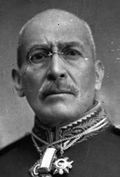 |
José Victoriano Huerta Márquez
b. 22 Dec 1850, Colotlán, Jalisco, Mexico
d. 13 Jan 1916, El Paso, Texas, United States |
| Title: |
Encargado del Poder Ejecutivo (In charge of the Executive Power) |
| Term: |
18 Feb 1913 - 19 Feb 1913 |
| Chronology: |
18 Feb 1913, assumed executive power, communication to the Cámara de Diputados (dated 18 Feb 1913, Mexico City) [1] |
| |
19 Feb 1913, appointed Secretary of State for the Interior (Secretario de Estado y del Despacho de Gobernación), decree of the Interim Constitutional President of the Mexican United States [2] |
| Title: |
Presidente Interino Constitucional de los Estados Unidos Mexicanos (Interim Constitutional President of the Mexican United States) |
| Term: |
19 Feb 1913 - 15 Jul 1914 |
| Chronology: |
19 Feb 1913, entered upon the duties of the office of Interim Constitutional President of the Mexican United States upon the resignation of an incumbent, resolution of the Cámara de Diputados of 19 Feb 1913 (promulgated as a decree 20 Feb 1913) [3][4] |
| |
19 Feb 1913, took an oath of office as Interim Constitutional President of the Mexican United States, session of the Congreso, Mexico City [5] |
| |
15 Jul 1914, resignation (dated 15 Jul 1914, Mexico City) is accepted, session of the Cámara de Diputados [6] |
| Names/titles: |
Sometimes erroneously recorded as José Victoriano Huerta Ortega |
| Biography: |
| Son of a cavalry soldier and a Huichol Indian; was trained at the Chapultepec Military College (1872-1876); commissioned as a student corporal (1874), student sub-lieutenant (1875), lieutenant in the Corps of Engineers on his graduation (1877); assigned as an adjutant of the General Staff (1878); promoted to first captain of the Special General Staff (1879); assigned to the Geographic Exploratory Commission (1879, 1881-1882); served in the campaign of the West (Sinaloa and Tepic) under general Manuel González (1879); promoted to major of the Special General Staff (1880); served as third engineer of the Geographic Exploratory Commission (1883-1890); promoted to lieutenant colonel of the Special General Staff (1884), colonel (1890); served as a highway engineer with a special commission to Veracruz; promoted to colonel of the Special General Staff (1890); appointed commander of the federal forces in the State of Guerrero (1895-1896); participated in the suppression of uprisings in Guerrero and Yucatán (1901-1902); brevetted brigadier general of the Special General Staff (1901); served as provisional commander of the 10th Military District (1902-1903); confirmed in the rank of brigadier general (1902); named a member of the Supreme Military Tribunal in 1903; was granted a leave (1907); held the office of head of public works in Monterrey; returned to military service as commander of the federal forces in the State of Guerrero (1911); took command of military operations in Morelos against the forces of Emiliano Zapata (1911); promoted to divisional general (1912); made head of military operations in the north against Pascual Orozco (1912); appointed president of the Supreme Council of War (1912-1913); took interim command of the garrison of Mexico City (1913); arrested President Francisco Madero and Vice-President José María Pino Suárez and jailed them in the National Palace; proclaimed himself chief executive (18 Feb 1913); appointed secretary of state for the interior (19 Feb 1913) by Interim President Pedro Lascuráin, who immediately resigned paving the way for Huerta's succession as Interim President; established a harsh military dictatorship; promoted to the general of the army (1914); encouraged militarization of Mexican society, the extensive use of forced conscription; bowed to internal and external pressure and resigned the presidency on 15 Jul 1914; went into exile, first traveling to Jamaica and then to Europe; arrived in the United States in 1915; conspired with German agents, planning to stage a coup in Mexico; arrested on sedition charges and imprisoned in Fort Bliss, Texas; died shortly after being released on bail. |
| Biographical sources: birth and baptismal record in Archivo de la Parroquia de San Luis en Colotlán, Jalisco, Bautismo de hijos legítimos, vol. 24, 1847-1851, fol. 237, #1198; "El Ejército Federal, 1914: Semblanzas Biográficas", by Mario Ramírez Rancaño (Mexico: Universidad Nacional Autónoma de México, 2012); obituary: New York Times, No. 21,174, 14 Jan 1916, pp. 1, 4. |
| |
| [1] |
Diario de los Debates de la Cámara de Diputados, No. 29, 19 Feb 1913, p. 10. |
| [2] |
Boletín oficial de la Secretaría de Relaciones, Nos. 2, 3 and 4, 28 Feb 1913, p. 70; Diario de los Debates de la Cámara de Diputados, No. 29, 19 Feb 1913, pp. 16-17. |
| [3] |
Diario Oficial, No. 37, 20 Feb 1913, pp. 423-424; Diario de los Debates de la Cámara de Diputados, No. 29, 19 Feb 1913, p. 18. |
| [4] |
The presidential line of succession was defined by the Constitution of 1857 (Art. 80 and 81 as amended 6 May 1904) and the law of 13 May 1891, and followed the order of Vice President, Secretary of State for External Relations (Secretario de Estado y del Despacho de Relaciones Exteriores) and the cabinet. The Secretary of State for the Interior (Secretario de Estado y del Despacho de Gobernación) was named second on the list of cabinet members defined by the law of 13 May 1891 and was the third in line of succession following Vice President and Secretary of State for External Relations (Diario Oficial, No. 116, 15 May 1891, p. 2; Diario Oficial, No. 5, 6 May 1904, pp. 68-71). |
| [5] |
Diario de los Debates de la Cámara de Diputados, No. 29, 19 Feb 1913, pp. 18-19. |
| [6] |
Diario Oficial, No. 14, 16 Jul 1914, p. 153; La Patria, No. 11, 729, 16 Jul 1914, p. 1. |

